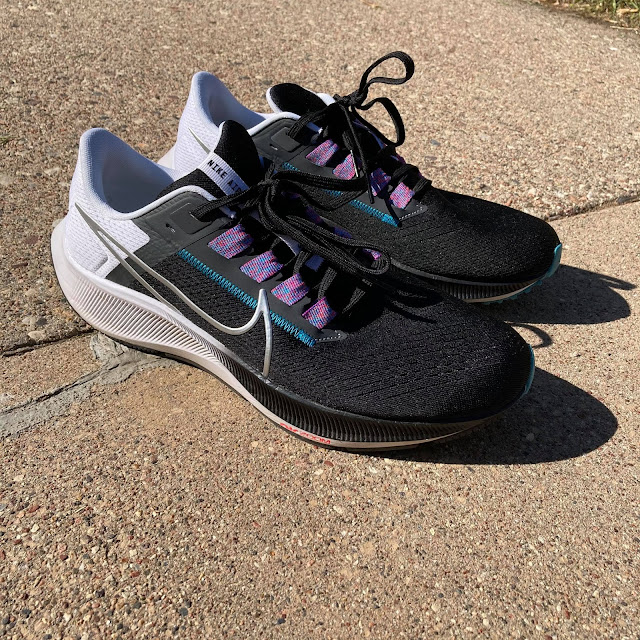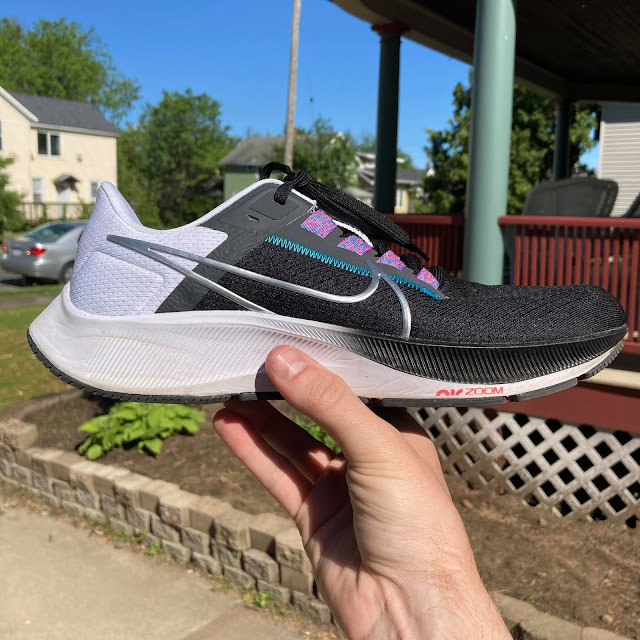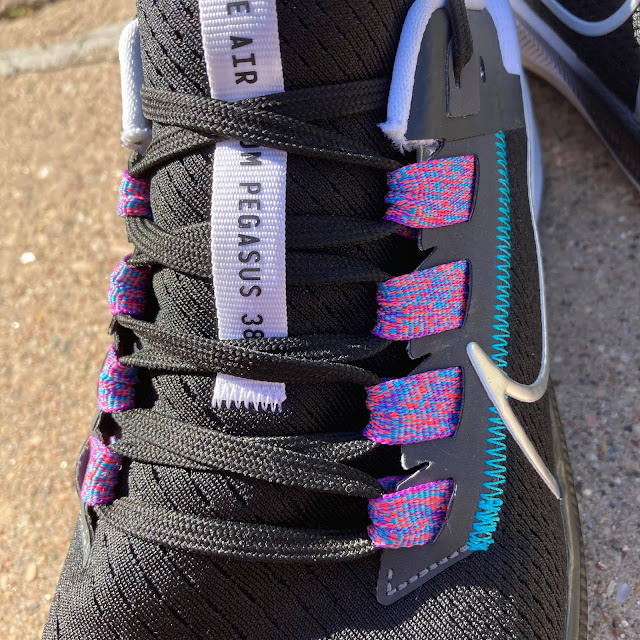Nike Air Zoom Pegasus 38 Review: Tightening Up the Upper
By Senior Contributor Nathan Brown
Believe it or not, this is the first Nike shoe I have ever owned and tested. Last year alone I tested over 70 shoes, and I was yet to don the swoosh on the side of my foot. I grew up in a house where Nike was not allowed (for reasons unbeknownst to me as a kid...I may have some guesses now), so even into adulthood I would not naturally gravitate to Nike footwear. It took our founder, Matt, purchasing a pair and sending it my way to get my feet in my first pair. No better than the trusted trainer: the Pegasus.
Nike Air Zoom Pegasus 38
Price: $119.95
Weight: 10.2oz (men's size 9); 8.5oz (women's size 8)
Stack Height: 23mm (heel), 33mm (forefoot)
Drop: 10mm
Price: $119
Classification: Daily Trainer
RUNNING SHOE SUMMARY
The Nike Pegasus 38 is a versatile, narrow-fitting, and truly neutral trainer that has been updated in the last two versions to include not only full-length Nike React foam, but also Zoom Air pods in the forefoot. The Pegasus packs a smooth, soft, and bouncy ride, but over time there are noticeable differences in the response of the foam and Zoom Air pods during the run, which may be worth considering for certain runners.
FIT (LENGTH / WIDTH / COMFORT)
The Pegasus 38 upper is a layered mesh, with the outer layer being a breathable engineered mesh and the inner layer being a soft and comfortable liner that is attached to the gusseted tongue. While comfortable, it does lead to two things. First is that it is slightly warmer -- not unbearably warm, but the dual layers in combination with the black color way was warmer even in the Wisconsin spring. Second, the thicker upper (and construction in general) is more snug and narrow. It is still true to size, but slightly on the snug side. The lacing system helps with creating individualized fit as there are 4 lacing loops that have connections through the lateral and medial side of midfoot so it can be synched down or loosened where you need it.
PERFORMANCE (RIDE / SPEED)
The midsole is made of two components: full length React foam and the Zoom Air pods which are placed in the forefoot. The ride of this shoe is smooth, soft, and bouncy. Certainly is on the more propulsive and fun end of the spectrum when it comes to daily trainers. The react foam and classic beveled heel is soft and smooth upon landing in the heel and transitions well to the forefoot. This is where the Zoom Air pods come into play. Early in runs, transitions to toe off are smooth and the Zoom Air pods do give a high amount of forefoot cushion/protection for the amount of stack. However, later in the run (for me after 45 minutes) I did start to notice the pods placing increased pressure when I would stop. For me, this did lead to some soreness in the balls of my feet, but may not be the case for all (more on this later).
Given the more snug upper and bouncy/responsive midsole this is a versatile trainer. It is soft and protective enough for recovery miles and taking it easy, but easily picks up the pace when opening up for tempos or strides.
STABILITY
The Pegasus is a true neutral shoe that sits on the more unstable size. The softer foam and narrow heel/midfoot outsole contact with the ground do not provide a lot of security in the shoe. What the shoe has going for it is very smooth transitions and a nice upper lockdown, which offsets some of the inherent instability.
THOUGHTS AS A DPT / FOOTWEAR SCIENCE
Let's talk about midsoles with multiple components and how that may influence how the shoe changes not only long term, but also within an individual run. Obviously we have the example here, where the Zoom Air pods are embedded within a React midsole. However, there are other examples like dual density midsoles like shoes with medial posts or the HOKA J Frame, or those with multiple foams with different constructions interacting (ASICS Glideride, Mizuno Wave Sky/Horizon).
We know that over the course of a single run, the matrix in foam compresses slightly by the end of the run (and then return to, or close to, its original shape). Additionally, over the course of weeks, the foam slowly stops returning fulling to its original shape, which is what eventually leads to a "dead" midsole when the shoe is ready to be replaced. So here lies the risk of varying components in a single midsole -- some of the components may compress or wear out more quickly than others, changing the effect of the shoe on the foot.
This was the case for me in the Peg 38. Even after 45 minutes, the React foam (which shows its wear immediately with some midsole creasing) compresses more quickly than the Zoom Air pods. This led to these pods becoming noticeable and placing more pressure on my forefoot. The issue is that for people with sensitive toe joints or metatarsals, this may become bothersome over time due to increased pressure in those areas. On the other side, some people might benefit from a forefoot unit (in the Zoom Air pods) that do not compress down and maintain the same amount of protection underneath. It's truly going to depend on the runner.
The same is going to be true for dual density midsoles. I often see in the clinic (anecdotal evidence alert) people who have posted shoes that tilt severely laterally when placed on a table. This is due to asymmetrical wear, where the softer midsole compresses more quickly over time than the post. People wearing shoes with combined midsoles should be conscious of the midsole wear and changes in the shoe, particularly if you have an injury history. This will also be accentuated for heavier runners and should be on their radar as they select shoes.
CHANGES FROM PEGASUS 37
The most important changes have come from the upper which now locks down in the heel firmly and gives a touch more room in the toe box. This helped create a more unified shoe, contributing to a more reliable daily trainer than last year's version which felt very snug and uptempo.
HISTORY OF THE NIKE PEGASUS LINE
The Pegasus line is perhaps the product that’s most
representative of Nike as a brand itself with its direct connection to
Greek mythology. The mystical winged horse is a central figure in Greek
mythology, most well-known for partnering with the hero Bellerophon to
fight the Chimera.
Nike adopted the Pegasus name not only for the
ties to Greek heritage, but for what he embodies: quickness, movement,
and the idea of flying through air. The first Pegasus was released in
1983 for $50 in a grey nylon upper with a light blue swoosh logo. It,
along with the Saucony Jazz and Puma Easy Rider, were part of a
revolution that helped bring in recreational joggers that ultimately
kickstarted the running shoe industry’s boom that we still live in
today. The shoe’s connection to air in particular has been it’s unique
signature over the years, from the Air Wedge in the early versions to
full length Air bags, “Visible Air”, and recently the Zoom Air Pods,
which offer an update to the many various implementations its had in
Nike running and basketball over the last 40 years.
Over 38 editions later, the Pegasus remains the staple of Nike running and an important piece of running shoe culture.
RECOMMENDATIONS
The Pegasus 38 is a wonderfully comfortable and fun shoe. I could see benefit of opening up the forefoot a bit for more room and thinning the upper a bit. However, the bigger change, I think, should be seen in how the Zoom Air pods were integrated. In my case the pods were too filled, and may integrate over longer runs if there was a bit less pressure in the pods.
WHO THIS SHOE IS FOR (Conclusion)
The Nike Pegasus 38 is a soft, bouncy, and versatile daily trainer who is for someone who has stable mechanics and is lighter on their feet. It is for someone looking for a shoe that can handle some workouts in addition to your daily miles and some medium-long runs.
GRADING
Nathan
Fit: B+ (Slightly snug, a bit warm, but was comfortable and locks down well)
Performance: A- (Really fun and smooth ride, but pods became noticeable after 45 minutes)
Stability: B- (Soft and narrow platform, but smooth transitions and secure upper helps)
DPT/Footwear Science: B+ (Zoom Air pods help with propulsion and maintaining forefoot cushion, but earlier wear of other midsole component limits the benefit and introduces variables that may affect the runner)
Personal: A- (Really fun ride, but limited utility for me due to the irritation from the pods)
Overall: B+
YOUTUBE REVIEW OF THE NIKE AIR ZOOM PEGASUS 38
Contributor Nathan Brown gives a video rundown of the Nike Air Zoom Pegasus 38! Get a little more in depth on Nathan's thoughts on the Peg's zoom air pods.
SHOP | SUPPORT DOCTORS OF RUNNING
Interested in purchasing the Nike Air Zoom Pegasus 38? Shop Running Warehouse here. Using the link to purchase helps support Doctors of Running. Thanks so much!
Shop gear we love!
Adios Pro 2: Fast, fun, and effective for those who need guidance due to overpronation
Mizuno Wave Rider 25: New full length Enerzy is a simple joy. Soft, flexible forefoot is unique
New Balance Rebel V2: Fast, fun, and surprisingly versatile
Rabbit Running Clothes: Incredibly soft, high quality clothing for your next run
Feetures Socks: Massively grippy socks that will make you feel more one with the shoe
Trigger Point Foam Roller: Help get those knots out post-run and feel better for tomorrow
Coros Pace 2 Watch: Excellent watch for various running goals and a massive battery life
Theragun Massager: This small version is great on the go for working tired legs
FURTHER READING
Compare Daily Trainer
Hoka Clifton 8 - The classic Hoka trainer returns for it's eighth iteration. Soft and comfortable, but maybe not for everyone as our editor Matt Klein goes into
Asics Novablast 2 - The 2020 favorite comes back with a restabilized heel aimed at accommodating more runners
Skechers GoRun Ride 9 - The very soft hyperburst provides a soft platform for everyday training in a relatively light package
Puma Velocity Nitro - Puma's brand new Nitro series delivers the Velocity, their well-priced daily trainer that we found does it all comfortably with a protective ride that's right in between soft and firm
Saucony Ride 14 - The Ride 13 was a bit hit in 2020 for being one of the best do-it-all trainers. 2014's version only refines the formula, making it the best Ride yet.
Recently at Doctors of Running
NEW: Stability Shoe Resource Center
Podcast Episode 51: Mailbag, Part 2
Visit our July Round Up for all the latest at Doctors of Running
Hoka One One Bondi X Review: We look into Hoka's latest carbon plated trainer
Thanks for reading!
TESTER PROFILES:
Dr. Brown is a 155 lb male with notable PRs of 18:18 5K, 39:25 10K, 1:29:01 half marathon, and 3:54 marathon. He typically runs between 20-40 miles per week at a variety of paces from 7:30-8:30 min/mile for recovery runs to 6-6:45 min/mile for tempo runs. He typically prefers shoes that provide some cushioning underfoot but still maintain a more firm and responsive feel. Current goals for 2020 are to break the 1.5 hour half marathon and 3:30 marathon. IG handle: @nate.docsofrunning
Doctor of Physical Therapy
Bach Pham MS
Marketing and Social Media Manager
NEXT: SAUCONY ENDORPHIN SPEED 2 REVIEW
















